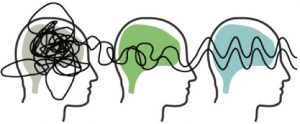Continuing our A to Z series, Meredith [placement student] describes in this blog post the concept of mental well-being.
What is well-being?
Well-being is portrayed in the media as a mental state that everyone should strive towards. Acting as an umbrella term for all positive feelings and states (happiness, prosperity, welfare etc.), the definition of well-being can be vague and there are an infinite number of options online for promoting good well-being.
Well-being is defined by the Oxford English Dictionary as ‘the state of being comfortable, healthy or happy’ but it also includes how satisfied people are with their life and their sense of purpose (Mental Health Foundation, 2015). This can be influenced by internal factors such as optimism and resilience, or external factors such as stress and poverty. Therefore, well-being is dynamic and easily changed in response to our environment.
“Well-being is defined …. as ‘the state of being comfortable, healthy or happy’”
How we measure well-being:
Current well-being can be measured using the 5 item WHO Well-being Index. This measure includes five statements asking about events and feelings in the past 2 weeks. Statements include: ‘I have felt cheerful and in good spirits’ and ‘my daily life has been filled with things that interest me’. Individuals are asked to indicate on a scale of 0 to 5 how often they felt that way, with 5 being ‘all the time’ and 0 being ‘no time’. The higher their total score, the better their well-being.
However, it is important to look beyond the number and view well-being in respect to other indicators relating to quality of life: such as health, socioeconomic status and social interaction. This provides a broader perspective on well-being and how well individuals manage on a day to day basis.
What affects well-being?
Well-being has been shown to be influenced negatively by environmental stressors, which individuals find difficult to cope with. Environmental stressors include socioeconomic status (Blanchflower & Oswald, 2004) and unemployment (Helliwell and Putnam, 2004). Religiosity, on the other hand, has been shown to increase well-being scores (Moberg & Taves, 2000), although it has been debated whether believing in a faith or belonging to a religious community is more influential.
Childhood events have also been shown to impact on well-being later in life. One study showed that being a victim of bullying at the ages of 7- 11 years resulted in lower scores on the Mental Well-being Scale (Takizawa, 2014).
 How do we improve our mental well-being?
How do we improve our mental well-being?
There are many ways to improve mental well-being such as being active, connecting with others around you, learning new skills, volunteering and being mindful (NHS, 2018).
The positive effects of mindfulness have been widely discussed in recently published literature. Mindfulness is a practice that aims to help individuals draw more awareness to their own current thoughts, feelings and surroundings in a non-judgmental way. It can potentially help people to feel more present and enjoy life more.
Mindfulness training has been shown to reduce stress in patients with chronic pain and anxiety (Bränström et al., 2010) as well as in university students who practiced mindfulness through yoga sessions more than three times a week (Shelov et al., 2009). These university students demonstrated an increased ability to pay attention to the present moment and focus less on the negative aspects of everyday life, which are key aspects in maintaining good mental well-being. See our previous blog post on mindfulness for further reading.
Improving and maintaining well-being is a worth-while task, as good mental health is crucial in enjoying happy and fruitful lives.
References:
Blanchflower, D. G., & Oswald, A. J. (2004). Well-being over time in Britain and the USA. Journal of public economics, 88(7-8), 1359-1386.
Bränström, R., Kvillemo, P., Brandberg, Y., & Moskowitz, J. T. (2010). Self-report mindfulness as a mediator of psychological well-being in a stress reduction intervention for cancer patients—A randomized study. Annals of behavioral medicine, 39(2), 151-161.
Helliwell, J. F., & Putnam, R. D. (2004). The social context of well-being. Philosophical Transactions of the Royal Society B: Biological Sciences, 359(1449), 1435.
Mental Health Foundation. (2015, July 20). What is wellbeing, how can we measure it and how can we support people to improve it? Retrieved from Mental Health Foundation: https://www.mentalhealth.org.uk/blog/what-wellbeing-how-can-we-measure-it-and-how-can-we-support-people-improve-it
Moberg, D. O., & Taves, M. J. (1965). Church participation and adjustment in old age. Older people and their social world, 113-124.
National Health Service. (2018). Improve Mental Wellbeing. Retrieved from NHS UK: https://www.nhs.uk/conditions/stress-anxiety-depression/improve-mental-wellbeing/
Oxford University Press. (2018). Retrieved from English Oxford Dictionaries : https://en.oxforddictionaries.com/definition/well-being
Shelov, D. V., Suchday, S., & Friedberg, J. P. (2009). A pilot study measuring the impact of yoga on the trait of mindfulness. Behavioural and cognitive psychotherapy, 37(5), 595-598.
Takizawa, R., Maughan, B., & Arseneault, L. (2014). Adult health outcomes of childhood bullying victimization: evidence from a five-decade longitudinal British birth cohort. American journal of psychiatry, 171(7), 777-784.
Topp, C. W., Østergaard, S. D., Søndergaard, S., & Bech, P. (2015). The WHO-5 Well-Being Index: a systematic review of the literature. Psychotherapy and psychosomatics, 84(3), 167-176.


